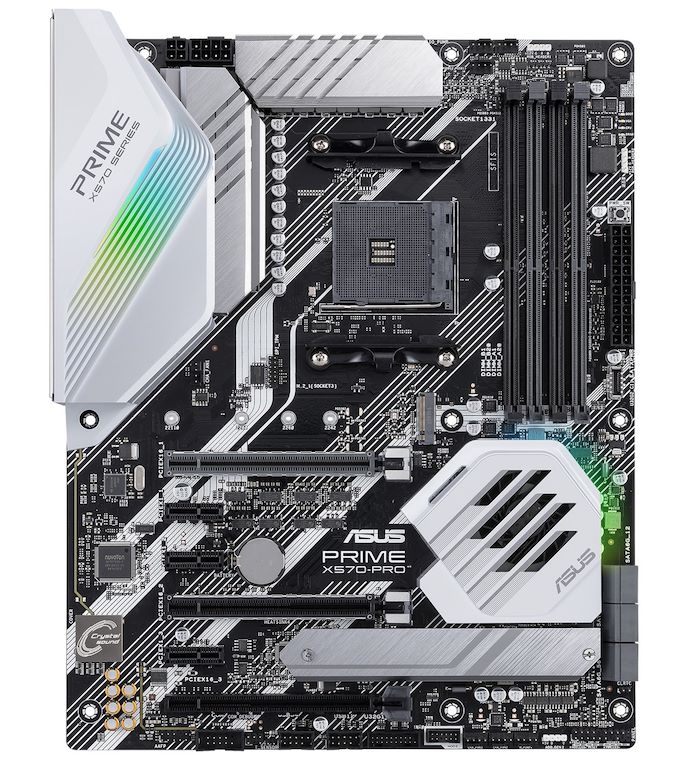The AMD X570 Motherboard Overview: Over 35+ Motherboards Analyzed
by Gavin Bonshor on July 9, 2019 8:00 AM ESTASUS Prime X570-Pro
Moving onto the ASUS Prime series of X570 motherboards, the ASUS Prime X570-Pro represents the more feature-laden of two ATX sized models; the other being the ASUS Prime X570-P. The ASUS Prime X570-Pro represents its less aggressive and non-gaming Prime range with a more subtle white and black aesthetic. The most notable aspects of the feature set include a Realtek S1220A HD audio codec, Gigabit NIC, and support for up to 128 GB of DDR4 memory.
The ASUS Prime X570-Pro offers three full-length PCIe 4.0 slots which run at x16, x8/x8, and x8/x8/x4. This allows for users to use two-way NVIDIA SLI and up to three-way AMD Crossfire multi-graphics card setups. Also present is three PCIe 4.0 x1 slots, with the board's storage capabilities coming through two PCIe 4.0 x4 M.2 slots, with the bottom slot coming with a heatsink; there are also six SATA ports with support for RAID 0, 1 and 10 arrays. In the top right-hand corner is four memory slots with support for up to 128 GB which allows users to install the 32 GB UDIMMs that has started making its way onto the market.
On the rear panel, the ASUS Prime X570-Pro includes three USB 3.1 G2 Type-A, one USB 3.1 G2 Type-C, and four USB 3.1 G1 Type-A ports. Adopters of AMD's impending Ryzen 3000 APUs and the Ryzen 2400/2200G will appreciate the HDMI and DisplayPort video outputs. There is also a PS/2 keyboard and mouse combo port, an Intel I211-AT Gigabit powered Ethernet port, and five 3.5 mm audio jacks and S/PDIF optical output driven by a Realtek S1220A HD audio codec.
The ASUS Prime X570-Pro has an MSRP of $250 and is more suited to users looking to avoid the swathe of gaming-themed models on the market. What the Prime series offers is elegant and neutral designs, which would actually look quite good with some RGB to make the white rear panel cover pop. There's support for two-way NVIDIA SLI and three-way AMD CrossFire too so users looking to build a more subtly styled gaming system can do so.












225 Comments
View All Comments
hubick - Wednesday, July 10, 2019 - link
Is dual M.2 off the CPU possible? In RAID 0?Every board seems to say one M.2 from CPU and others from chipset :-(
DanNeely - Wednesday, July 10, 2019 - link
IIRC the x16 PCIe from the CPU can only be split down to x8/8 so you'd need to add an extra (expensive) chip to farther split it to x8/4/4.Otherwise you only have 1 x4 from the CPU itself. The x16/4/4 that AMD claims is somewhat deceptive since one of the x4's is used for the chipset and thus not available for general use.
hubick - Wednesday, July 10, 2019 - link
Doesn't this disagree with you? https://images.anandtech.com/doci/14605/X570.pngQasar - Thursday, July 11, 2019 - link
how does it disagree ??mike_cz - Wednesday, July 10, 2019 - link
Does any of these motherboards support IPMI or something equivalent?ajp_anton - Wednesday, July 10, 2019 - link
ASUS ROG Crosshair VIII Impact:"Also featured in addition to the dual PCIe 4.0 M.2 slots are eight SATA ports which is quite an impressive feat given the board's smaller form factor."
No, it has 4 SATA ports.
kiranskinclinic - Wednesday, July 10, 2019 - link
Excellent content and thank you so much for share your knowledgeFor know more related details click on below activate link.
https://kiranskinclinic.com/
NOTELLN - Wednesday, July 10, 2019 - link
All the VRM core counts are wrong. Its as if some numbskull just counted caps and knows nothing about motherboards or cores.gavbon - Wednesday, July 10, 2019 - link
This is the information we have received from the vendors themselves. Until we take a look at each board and do the analysis, it would be hard. Unless you know someone who has images/inspected each of the 35+ boards in person to do this?Scootiep7 - Wednesday, July 10, 2019 - link
Really thinking that a simple comparrison chart that listed all the MOBO's you tested on one axis and the features people might look for on the other axis with prices at the far end would have helped you reduce the wasted space on your conclusion page as well as present the findings in a more concise manner. Just food for thought.